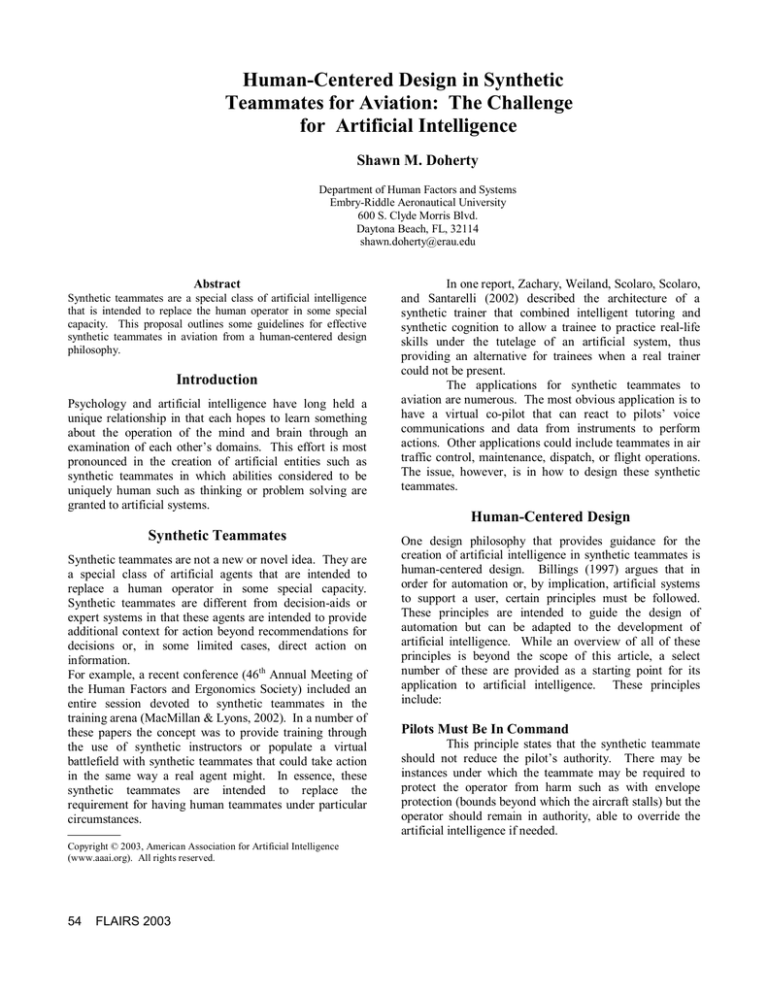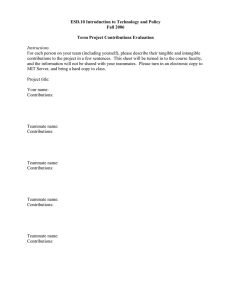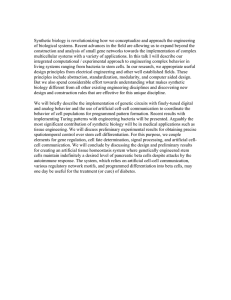
Human-Centered Design in Synthetic
Teammates for Aviation: The Challenge
for Artificial Intelligence
Shawn M. Doherty
Department of Human Factors and Systems
Embry-Riddle Aeronautical University
600 S. Clyde Morris Blvd.
Daytona Beach, FL, 32114
shawn.doherty@erau.edu
Abstract
Synthetic teammates are a special class of artificial intelligence
that is intended to replace the human operator in some special
capacity. This proposal outlines some guidelines for effective
synthetic teammates in aviation from a human-centered design
philosophy.
Introduction
Psychology and artificial intelligence have long held a
unique relationship in that each hopes to learn something
about the operation of the mind and brain through an
examination of each other’s domains. This effort is most
pronounced in the creation of artificial entities such as
synthetic teammates in which abilities considered to be
uniquely human such as thinking or problem solving are
granted to artificial systems.
Synthetic Teammates
Synthetic teammates are not a new or novel idea. They are
a special class of artificial agents that are intended to
replace a human operator in some special capacity.
Synthetic teammates are different from decision-aids or
expert systems in that these agents are intended to provide
additional context for action beyond recommendations for
decisions or, in some limited cases, direct action on
information.
For example, a recent conference (46th Annual Meeting of
the Human Factors and Ergonomics Society) included an
entire session devoted to synthetic teammates in the
training arena (MacMillan & Lyons, 2002). In a number of
these papers the concept was to provide training through
the use of synthetic instructors or populate a virtual
battlefield with synthetic teammates that could take action
in the same way a real agent might. In essence, these
synthetic teammates are intended to replace the
requirement for having human teammates under particular
circumstances.
Copyright © 2003, American Association for Artificial Intelligence
(www.aaai.org). All rights reserved.
54
FLAIRS 2003
In one report, Zachary, Weiland, Scolaro, Scolaro,
and Santarelli (2002) described the architecture of a
synthetic trainer that combined intelligent tutoring and
synthetic cognition to allow a trainee to practice real-life
skills under the tutelage of an artificial system, thus
providing an alternative for trainees when a real trainer
could not be present.
The applications for synthetic teammates to
aviation are numerous. The most obvious application is to
have a virtual co-pilot that can react to pilots’ voice
communications and data from instruments to perform
actions. Other applications could include teammates in air
traffic control, maintenance, dispatch, or flight operations.
The issue, however, is in how to design these synthetic
teammates.
Human-Centered Design
One design philosophy that provides guidance for the
creation of artificial intelligence in synthetic teammates is
human-centered design. Billings (1997) argues that in
order for automation or, by implication, artificial systems
to support a user, certain principles must be followed.
These principles are intended to guide the design of
automation but can be adapted to the development of
artificial intelligence. While an overview of all of these
principles is beyond the scope of this article, a select
number of these are provided as a starting point for its
application to artificial intelligence. These principles
include:
Pilots Must Be In Command
This principle states that the synthetic teammate
should not reduce the pilot’s authority. There may be
instances under which the teammate may be required to
protect the operator from harm such as with envelope
protection (bounds beyond which the aircraft stalls) but the
operator should remain in authority, able to override the
artificial intelligence if needed.
Pilots Must Be Informed
Pilots Must Be Informed
This principle states that the synthetic teammate
must provide feedback to the pilot indicating what the
teammate is doing. Only if this feedback is generated will
the pilot be able to take adequate action based on what the
synthetic teammate is doing. In the absence of this
feedback, pilots may experience automation surprises
(Sarter & Woods, 1995) when the synthetic teammate does
something the pilot does not anticipate.
The challenge of keeping the pilot informed about
the actions of the synthetic teammate is more than merely
providing verbal or textual feedback from the artificial
system. This feedback must be meaningful to the pilot. If
a synthetic teammate is intended to replace the copilot in
an aircraft, the synthetic system should be able to provide
information in a manner that is consistent with the actions
and operations of a real copilot. This concern does not
mean that the synthetic teammate requires high fidelity of
response compared to a human copilot, but rather than the
actions and information provided by the system are in
meaningful terms for the aviation context.
Automation Must Be Predictable
A corollary to the previous principle is that the
actions of the synthetic teammate must be predictable.
Even if the synthetic teammate provides adequate
feedback, the teammate’s actions need to be predictable
enough that the pilot can anticipate the synthetic teammate
and take appropriate action. Without a certain level of
predictability, even if there is sufficient feedback the pilot
may not have enough time to prepare a coordinated
response with actions performed by the synthetic
teammate.
Automation Must Support the Pilot
Perhaps the most important principle, this
principle states that automation should support the pilot.
The purpose of a synthetic teammate should be to provide
cognitive support, either in areas of decision-making,
problem-solving, information collection and integration, or
automatic data processing.
The Challenge
So what is the implication for artificial intelligence?
Numerous efforts have been made to create artificial
intelligence in different scales ranging from full-fledged
artificial humans to, more recently, artificial agents that are
specialized for particular functions such as internet
searches (web-bots).
So the challenge to artificial intelligence is in how
these synthetic teammates can be created to support the
operator.
Pilots Must Be In Command
The challenge to artificial intelligence is in the
creation of an artificial intelligence that does not override
the operator. While this challenge may seem trivial in
concept, automation systems have a long track record of
trumping the authority of the pilot. This tendency may
become more pronounced when developing a human-like
synthetic teammate. If the teammate is intended to
perform more like a real human in order to coordinate
actions in the cockpit, the risk of enabling the synthetic
teammate to supercede the true pilot increases.
Automation Must Be Predictable
While this principle may be clear in computing
terms by detailing all possible states of the synthetic
teammate or completely mapping out the synthetic
teammate’s possibilities for action, this mapping does not
mean that those system states may not surprise the human
pilot if there are large transitions between those states. If a
human teammate requests information from the synthetic
teammate on one aspect of information in the cockpit and
the synthetic teammate responds with different response
patterns each time it is requested, it may not be clear what
ties those differences in actions or states in the synthetic
teammate together for the pilot for the same request. This
issue becomes especially challenging as the complexity
and the number of possible system states or responses
increases in the synthetic teammate.
Automation Must Support the Pilot
Pilot support should be the ultimate goal of
synthetic teammates. In the case of synthetic teammates,
they should still remain a tool to support the actions of the
pilot, not replace them. This support can emerge from
information gathering, integration, or providing expert
information that the pilot requires. If, however, the
synthetic teammate doesn’t support the pilot due to lack of
feedback,
unpredictability,
or
excess authority,
performance in the pilot may decrease because the pilot
has to either counteract the synthetic teammate or spend
precious time trying to decipher the actions of the
teammate (Bainbridge, 1981).
Notice, also, that synthetic teammates may
support the operator in certain domains more easily than
others. For example, synthetic teammates may make more
sense in the training domain where they can guide the
trainee through tasks but may make less sense in the
cockpit where lack of support via the synthetic teammate
may interfere with the pilot.
FLAIRS 2003
55
The Appeal to Artificial Intelligence
While this document might not provide insight into the
exact underlying architecture of how these synthetic
systems should operate, it does provide direction and
guidelines in the creation of artificial synthetic teammates.
Human-centered design addresses concerns for the
boundaries of synthetic teammates and some of the global
characteristics of these teammates that need to be present
in order to be effective.
However, more specific characteristics also need
to be addressed to answer in the design of such a
teammate, such as what the personality of a synthetic
teammate might be (cf: Vallence, Litzinger, & Wise,
2001), the level of emotion or politeness that should be
exhibited by a synthetic teammate, or the method of
interaction of the synthetic teammate with the pilot. All of
these concepts are other aspects of design that
collaboration of psychology or human factors with
artificial intelligence can address to make these systems
more effective.
References
Bainbridge, L. 1983. Ironies of automation. Automatica,
19(6), 775-779.
Billings, C. E. 1997. Aviation automation: The search for
a human-centered approach. Mahwah, NJ: Lawrence
Erlbaum
MacMillan, J., & Lyons, D. 2002. Symoposium using
synthetic teammates to train teamwork skills: Perspectives
and issues. Proceedings of the Human Factors and
Ergonomics Society 46th Annual Meeting, Santa Monica,
CA: Human Factors and Ergonomics Society.
Sarter, N. B., & Woods, D. D. 1995. “How in the world
did we get into that mode?” Human Factors, 37(1), 5-19.
Vallence, S., Litzinger, T., & Wise, J. A. 2001. A nontraditional approach to understanding total system
performance of avionics systems. Proceedings of the 20th
Digital Avionics Systems Conference, Daytona Beach, FL,
IEEE.
Zachary, W., Weiland, W., Scolaro, D., Scolaro, J.,
Santarelli, T. 2002. Instructorless team training using
synthetic teammates and instructors. Proceedings of the
Human Factors and Ergonomics Society 46th Annual
Meeting, Santa Monica, CA:
Human Factors and
Ergonomics Society.
56
FLAIRS 2003







